Rail Crash of September 1867
In September 1867, a rail disaster occurred on the Peak Forest line which runs through New Mills Central Station, joining Manchester and Buxton. The scene following the incident at New Mills was captured in an engraving. The engraving shows the scene of destruction below the Midland Railway Bridge in the Torrs
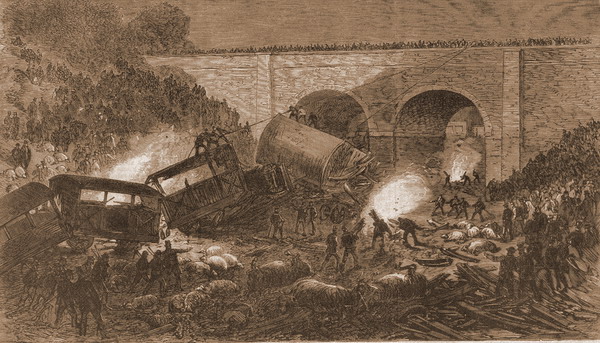
‘It was a double accident. In the first instance a , a collision occurred between a cattle train and a ballast train in the Peak Forest tunnel. The greater part of the cattle train was detached by the shock and sent rolling down the inclined road for miles until it came into collision with an express passenger train and the latter in its turn, was impelled backwards some miles further till a change of gradients bought it to a standstill. It was between five and six in the evening when the cattle train entered the tunnel at Chapel-en-le- Frith . It was a very heavy train of 25 trucks, containing about 1,000 head of sheep and cattle. A ballast train had preceded it into the tunnel on the same line of rails and according to the rule, the signalman at the Chapel-en-le- Frith end should have allowed no second train to enter till a signal from the southern end announced that the first train had passed out. The signalman, however negligently allowed the cattle train to pass into the tunnel which is a long one and when it had reached the midst it dashed into the ballast train which had been stopped to unload. The ballast train consisting of ten wagons and eight men, was standing in the tunnel around a quarter of a mile from the Buxworth (known then as Bugsworth) entrance. Some fifty or sixty navvies were throwing ballast onto the road when the heavy cattle train, travelling from Liverpool to Birmingham, suddenly ran into it. The cattle train consisted of twenty seven trucks full of beasts, a third class carriage in which the eight or nine drovers were travelling and a brake van was drawn by two powerful engines.
None of the navvies was injured by the collision, but the daughter of a blacksmith, Martha Vaines of Dove Holes, who happened to be sitting in the brake van of the ballast train was killed instantly. The little girl had missed her train at Buxworth and had received permission to ride in the brake van from there to her home. The van was broken into pieces, three or four of the ballast wagons were thrown off the line and damaged. Both lines were blocked with debris. The engines likewise slipped off the metals and one of them was partially buried in the wreck of the ballast train.
The coupling chain which had attached the foremost truck or wagon to the nearest engine was broken off, and immediately after the collision the whole cattle train without the engine was again in motion in the contrary direction to that which it had come. The guard immediately applied the brakes, but against the weight of the runaway wagons, they were useless. The steep gradient added to the train’s momentum at every yard and as the train came out of the tunnel, the brakeman and a drover jumped out. The three other men who were in the passenger carriage, named Sinkins, Sneiton and Wall, followed their example, but the last two sustained severe head injuries and were taken to an inn at Chapel.
The other five men clung to their places and were fated to suffer in the second collision which occurred after the runaway trucks had travelled back a distance of more than eight miles at express speed, passing through the Buxworth station. As it passed through Buxworth, the signalman blocked the line so that no trains should pass the New Mills signal box and telephoned New Mills station that a runaway was descending on the wrong line. The message however, arrived too late to be of service for the express train from Manchester had passed through the station in safety and the tunnel about 200 yards beyond. On emerging from the tunnel the driver Edward Cooper of Buxton, found a signal against him, and has the rules require the speed to be moderated at this point had no difficulty in stopping his train.
Neither he nor the signalman knew the nature of the danger that threatened them. The guard ran to the front of the train to ask the cause of the stoppage, and Mr Lofts, stationmaster was about to step up onto the engine with the same object, when the observed the cattle train coming towards them round the curve on the same line, ‘in a perfect cloud of dust at a speed of not less than 40 to 50 miles an hour.’
The stoker jumped off the engine and ran with the guard and Mr Lofts out of the way. Cooper the driver of the express, bravely threw the engine into reverse and turned on full power, with a view to checking the collision which was unavoidable. But before the passenger train had gone back six yards and as Cooper was jumping clear the cattle train struck it. The scene was described as appalling. The funnel, dome and other projections on top of the express engine were swept away by cattle trucks which were at once piled upon it.
One or more sheep were pitched out of the cattle train upon the engine, which fortunately maintained its position and gradually drew backwards out of the mass of debris that had been thrown against it. The guards van and passenger carriage attached to the cattle train were completely smashed and the largest part of either that remained intact was part of a door of the passenger carriage. Twelve or thirteen of the cattle trucks were completely wrecked , lifted off their wheels, and the woodwork so torn and riven that they looked like a mass of firewood. An area, about fifty yards long and ten yards wide, became one vast heap of twisted metal, broken timber, and dead and dying cattle. Buried beneath it was Cooper , the driver of the express, who was soon got out and found to be severely injured, but recovered. The five drovers were in the very thick of the wreck, two were found dead and two expired soon after. The fifth man named Baker was not so badly hurt and was taken to Stockport infirmary.
Meanwhile the driverless express train had gained extra impetus from the collision as it backed away from the cattle trucks and was moving with its passengers back toward Manchester. The New Mills station master telegraphed Marple and Romiley that a train was descending the incline on the wrong line, and at Marple it was turned upon another set of metals so that it might not meet an advancing train. It was still going to fast to allow anyone to jump on it, but it was at length bought to a standstill when ascending an incline near Romiley. Some of the passengers were found to be severely shaken, but the consequences were not likely to prove serious. On the engine was discovered the remains of a sheep which had been thrown out of one of the cattle trucks by the violence of the collision at New Mills. Among the damage at New Mills was the destruction of the signal box in which were two men who had escaped uninjured.
Men were quickly employed to clear the line and remove the cattle and it was found that thirty sheep had been killed and twenty more had to be destroyed. Eight bullocks had also been killed and others so seriously wounded that they had to be slaughtered. The point’s man and his little child had narrow escapes. His box received considerable damage, a large piece of iron being driven completely through it. His little girl was sitting with him, at tea in the box, and was slightly hurt. The express driver, Cooper , whilst jumping, was cut by one of the trucks and dragged several yards along with it as it rebounded after the collision. He was among the wreckage , much cut about the head and legs, but it was hoped he would recover. Men worked all through the night by the light of large fires to clear the lines at New Mills and within the tunnel, but such was the damage only one line was ready for use the following day.
Rail Crash - November 1948
After a light engine had crashed into the rear of his wagon train standing outside New Mills station in thick fog, derailing three wagons and a brake van and blocking both lines, the driver of the empty wagon train hurried from his cab placed fog signals on the other line and stopped a passenger train just short of the debris which obstructed the track. The empty wagon train going from Manchester to Gow Hole Sidings was stationary was stationary on the Strines side of New Mills station, when the light engine crashed into its rear. The brake van at the end of the stationary train and the next wagon, were forced off the lines. Two other wagons, next to the engine of the stationary train, were thrown upwards and finished ‘locked’ together like an inverted ‘V’ sign.
In the crash, Samuel Robertshaw driver of the light engine injured his ribs. He was attended by Dr Ryan, and taken to Stockport Infirmary. To take Robertshaw to hospital, a Buxton ambulance had to make a ten mile journey, in thick fog taking over an hour to New Mills. Both the New Mills ambulances were out on other calls. Robertshaw walked from the station booking office into the ambulance with the help of railwaymen.
The fireman of the light engine was slightly injured on the hand, but the one who had the luckiest escape was Percy Kaye of New Mills, guard on the stationary train.
He leapt from his van just before the crash. The wreckage blocked both the up and down lines and the driver of the stationary train, with great presence of mind dashed to put fog signals on the other line, and the 4-16 p.m. New Mills to Manchester passenger train which was just leaving New Mills pulled up short of the debris obstructing the line. Driver of the passenger train was Len Wood foreman driver at Hayfield, who took his train back to Hayfield after some passengers had alighted.
Traffic through New Mills on both the Hayfield and Chinley lines was at a standstill. Railway officials were soon on the scene and everything was done to minimise inconvenience to passengers. Scholars from New Mills Grammar School, living in Chinley and beyond, were late home, as the train on which they normally travel could not get through and they had to wait for a train from Chinley to take them home at about six o’clock.
A breakdown gang and crane arrived and working in the fog with the aid of lamps set about removing the wreckage. It was around midnight before the last of the derailed wagons was removed and the lines cleared.
Rail Crash at Central Station 1960
By the light of arc lamps breakdown gangs using two large cranes from Gorton and Derby cleared the track after a six coach diesel train had ploughed into the back of a goods train, injuring the driver and a boy and girl.
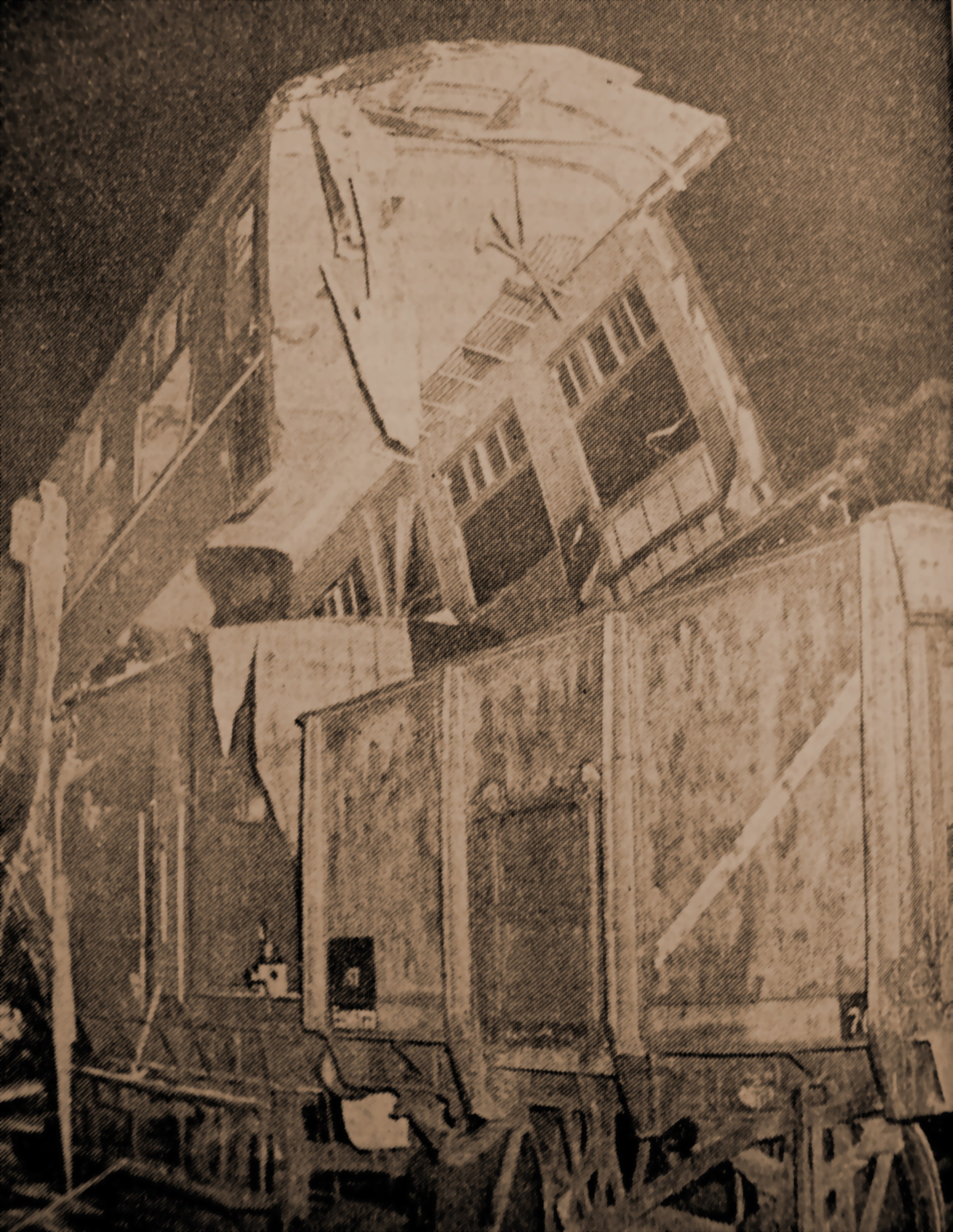 Only a few hundred yards from New Mills Central Station the diesel rammed into the goods train which had just started to move forward. The first coach, in which the three injured were traveling, leapt about 20 feet upward. Its bodywork shot on top of the guard’s van of the goods train. Driver Evan Jones was hurled from his wrecked diesel cab and thrown into the damaged guards van, and was seriously injured. The girl, 10 year old Margaret was pinned by the legs in seat wreckage and debris in the shattered coach high above the ground. Also injured was a New Mills schoolboy called Philip. Only a few hundred yards from New Mills Central Station the diesel rammed into the goods train which had just started to move forward. The first coach, in which the three injured were traveling, leapt about 20 feet upward. Its bodywork shot on top of the guard’s van of the goods train. Driver Evan Jones was hurled from his wrecked diesel cab and thrown into the damaged guards van, and was seriously injured. The girl, 10 year old Margaret was pinned by the legs in seat wreckage and debris in the shattered coach high above the ground. Also injured was a New Mills schoolboy called Philip.
For ninety minutes firemen using hacksaws and axes fought to free her. But courageous Margaret - who had been reading a book on her way home from Harrytown Convent School, Romiley, remained calm. She did everything her rescuers told her to do, as they cut through the wreckage. Her parents who have a business in Union Road dashed to the scene. They clambered down the grassy embankment below Hague Bar Road and saw their trapped daughter - wearing a fireman’s helmet to protect her from falling glass Margaret spotted them and waved. Her father said ‘someone took off the helmet, and she managed to twist her neck and look at us. Then she waved. Her parents remained at the scene watching the rescuers toiling until Margaret had been freed. They were with her as she was carried, strapped on a stretcher up the embankment to the ambulance. ‘Don’t worry I’m alright’ she told them. Then they went in the ambulance to the infirmary with her. Her father later said ‘she was a very lucky girl. She had a cut on her leg’
 Margaret had been sitting toward the front of the diesels first coach, and in front of her, just behind the driver, was 12 year old Philip. He had got up and left his seat as the train was nearing New Mills - a move which probably saved him from serious injury. He had gone toward the door. He was the first of the three to be rescued, and he was taken to Stockport Infirmary suffering from shock and bruises. His mother said it was thought he might have broken a bone in his heel. Mrs. Jones wife of the driver said ‘ he did not seem to know what had happened. He could not speak properly. He has been on the railway since he was 14 and has been driving diesels for two years.’ Philip said ‘ There was a terrific crash and everything began flying around. Luckily they got me out in next to no time.’ Margaret had been sitting toward the front of the diesels first coach, and in front of her, just behind the driver, was 12 year old Philip. He had got up and left his seat as the train was nearing New Mills - a move which probably saved him from serious injury. He had gone toward the door. He was the first of the three to be rescued, and he was taken to Stockport Infirmary suffering from shock and bruises. His mother said it was thought he might have broken a bone in his heel. Mrs. Jones wife of the driver said ‘ he did not seem to know what had happened. He could not speak properly. He has been on the railway since he was 14 and has been driving diesels for two years.’ Philip said ‘ There was a terrific crash and everything began flying around. Luckily they got me out in next to no time.’
A police official said it was a miracle there were so few injuries. The emergency services were quickly on the scene. Said one fireman: ‘the guard of the goods train said he had seen the crash coming and jumped clear. Driver Jones had been thrown into the guards van, and had wreckage on his legs when we rescued him.’
One way traffic operated on Hague Bar Road, as there was a long line of ambulances, fire engines and police cars blocking one lane. Two local doctors Dr. L. Millward and Dr. A. R. Robinson dashed to the crash. Painkilling morphia injections were given to driver Jones and Margaret. Said Dr. Millward; she was trapped by twisted wreckage. Firemen got a thick rope round one end of the coach to make sure there was no more pressure on her legs. It was a difficult job to get her out. She must have been in pain, but never made a murmur. She was very brave and did not struggle or move a muscle until we told her what to do.’
The driver Evan Jones, a former mayor of Duckinfield, suffered serious injuries, but made a full recovery.
Derailed Stone Wagons - August 1968
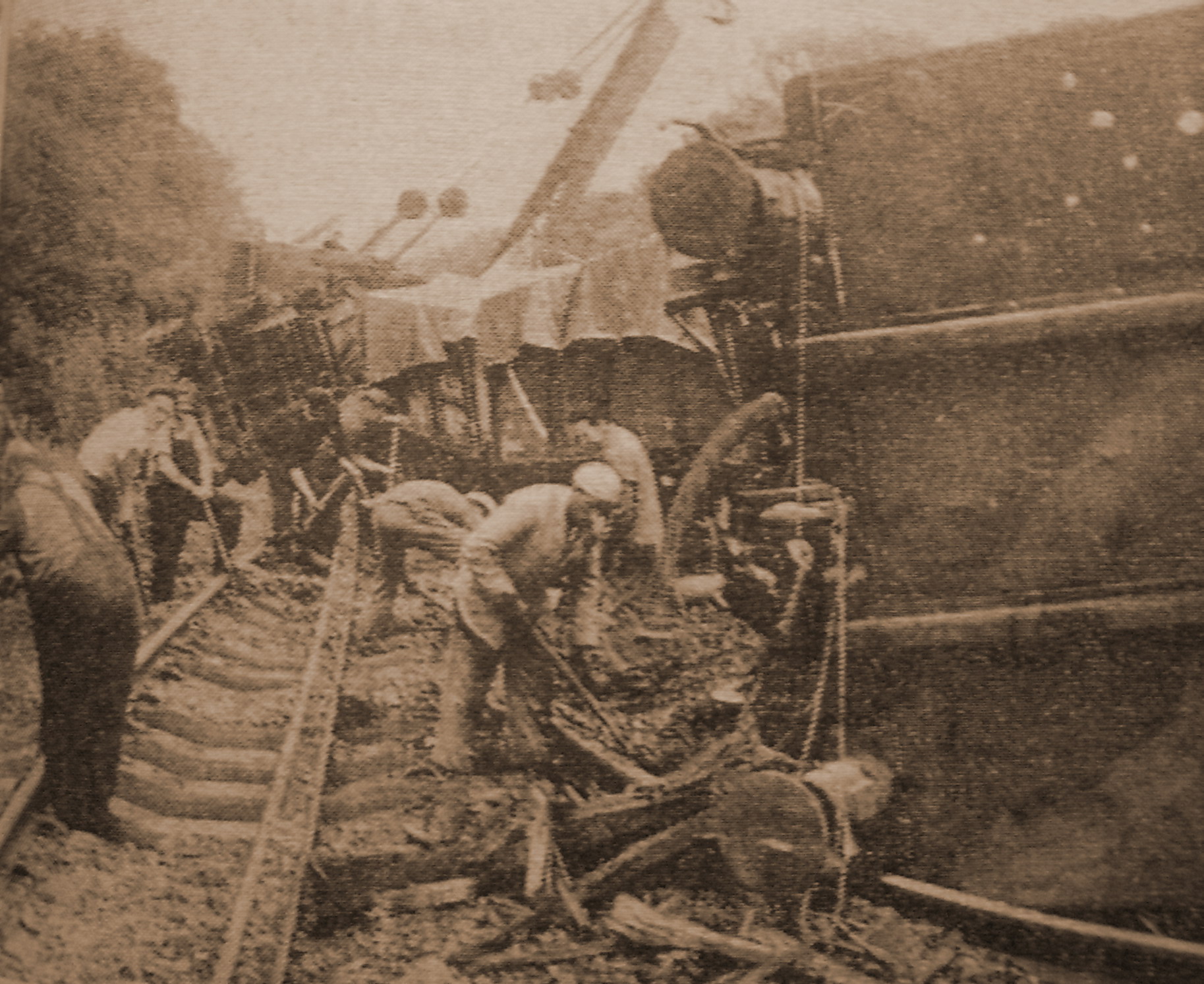 More than thirty wagons were derailed on the railway between New Mills and Disley spilling hundreds of tons of Limestone onto the tracks, blocking both lines. The 5 p.m. train from Grindleford to Trafford Park was about a mile from the New Mills end of the Disley tunnel, above the Knathole Wood, when the diesel locomotive and the first two wagons divided from the rest of the train as a result the remaining thirty three wagons became derailed. The incident occurred at about 6 p.m. but no-one was injured. The train was carrying between five and six hundred tons of stone for shipment, and workmen faced the task of removing the stone before repairing the tracks and getting the wagons back onto the lines. The line is known locally as the ‘middle line’ on which the London trains used to run is now used for freight traffic only. Following the blockage trains were rerouted. More than thirty wagons were derailed on the railway between New Mills and Disley spilling hundreds of tons of Limestone onto the tracks, blocking both lines. The 5 p.m. train from Grindleford to Trafford Park was about a mile from the New Mills end of the Disley tunnel, above the Knathole Wood, when the diesel locomotive and the first two wagons divided from the rest of the train as a result the remaining thirty three wagons became derailed. The incident occurred at about 6 p.m. but no-one was injured. The train was carrying between five and six hundred tons of stone for shipment, and workmen faced the task of removing the stone before repairing the tracks and getting the wagons back onto the lines. The line is known locally as the ‘middle line’ on which the London trains used to run is now used for freight traffic only. Following the blockage trains were rerouted.
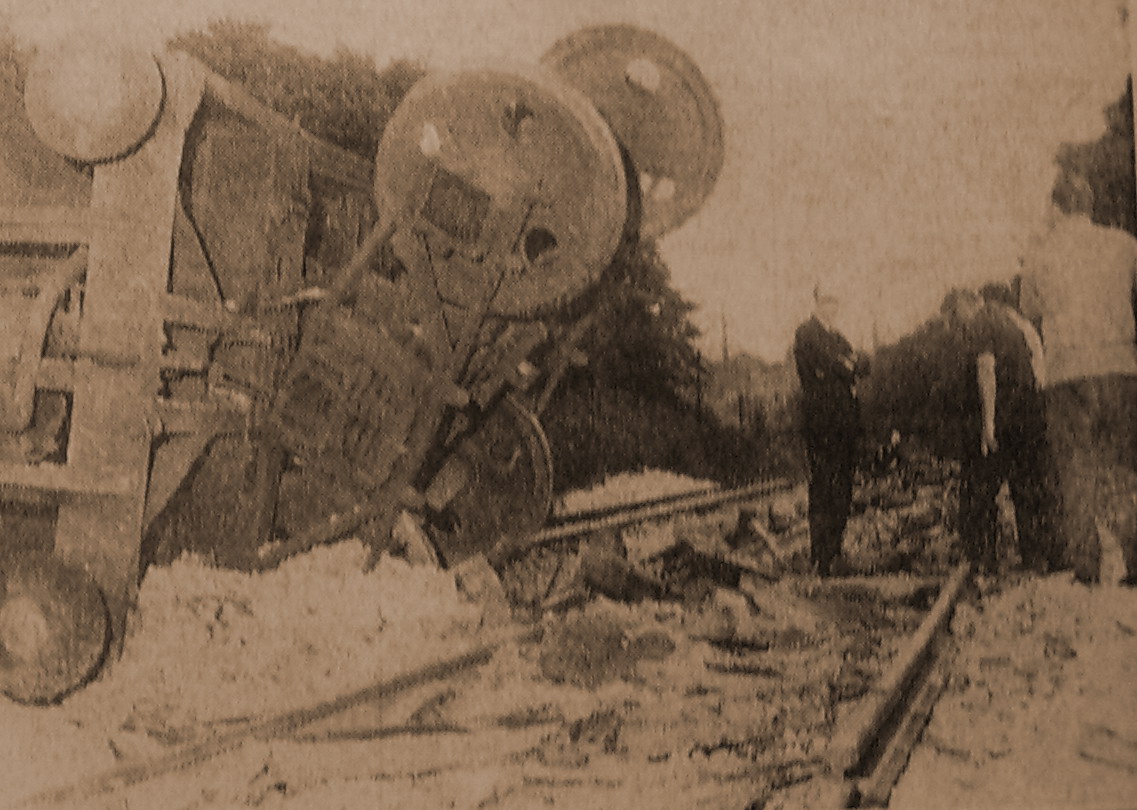 Almost exactly a year later the last three wagons of an I.C.I. ‘hopper train’ taking limestone from the company’s quarry at Tunstead, Peak Forest to its Oakliegh Works, Chester were derailed and overturned between Newtown and Disley. Almost exactly a year later the last three wagons of an I.C.I. ‘hopper train’ taking limestone from the company’s quarry at Tunstead, Peak Forest to its Oakliegh Works, Chester were derailed and overturned between Newtown and Disley.

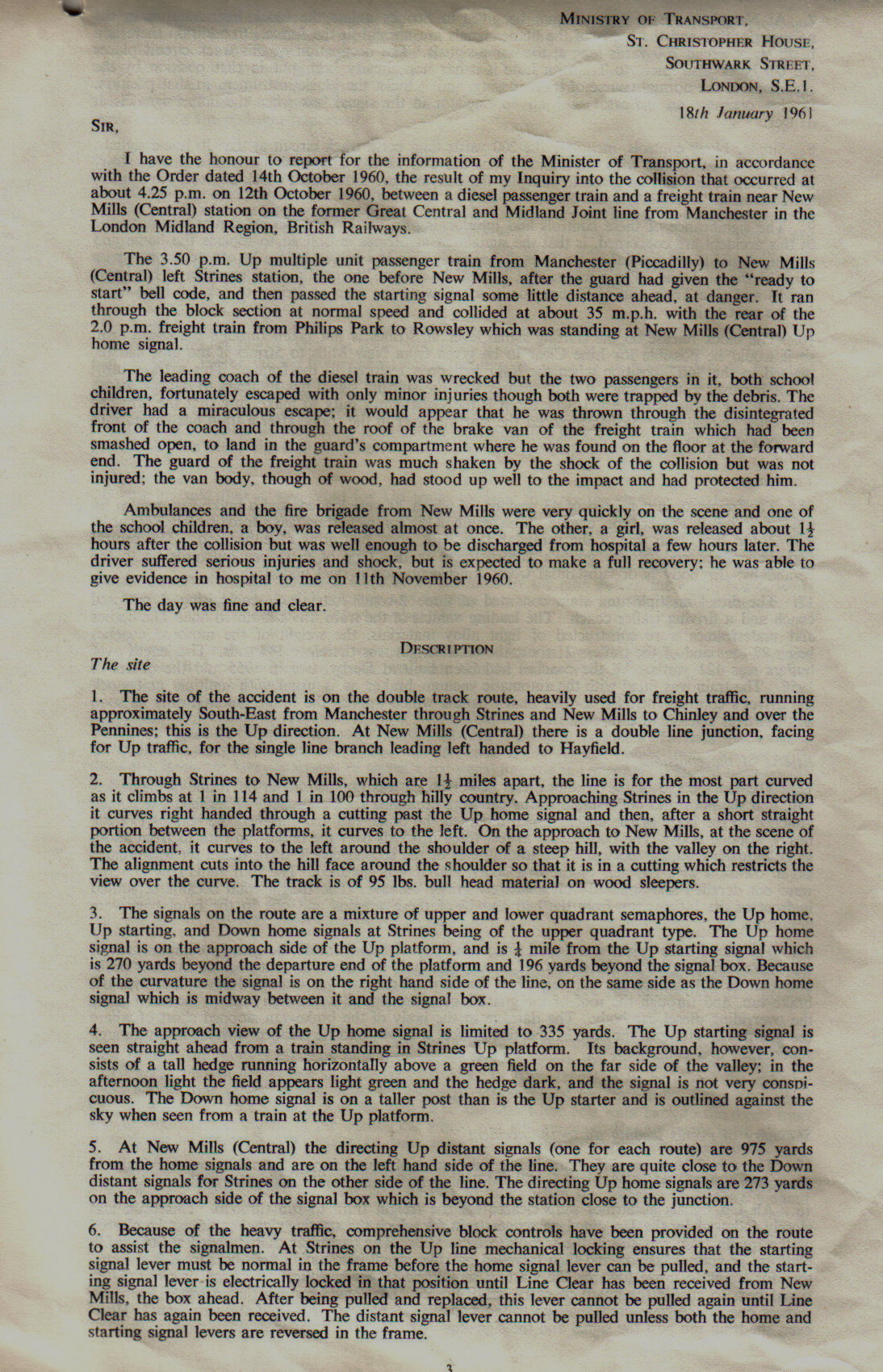
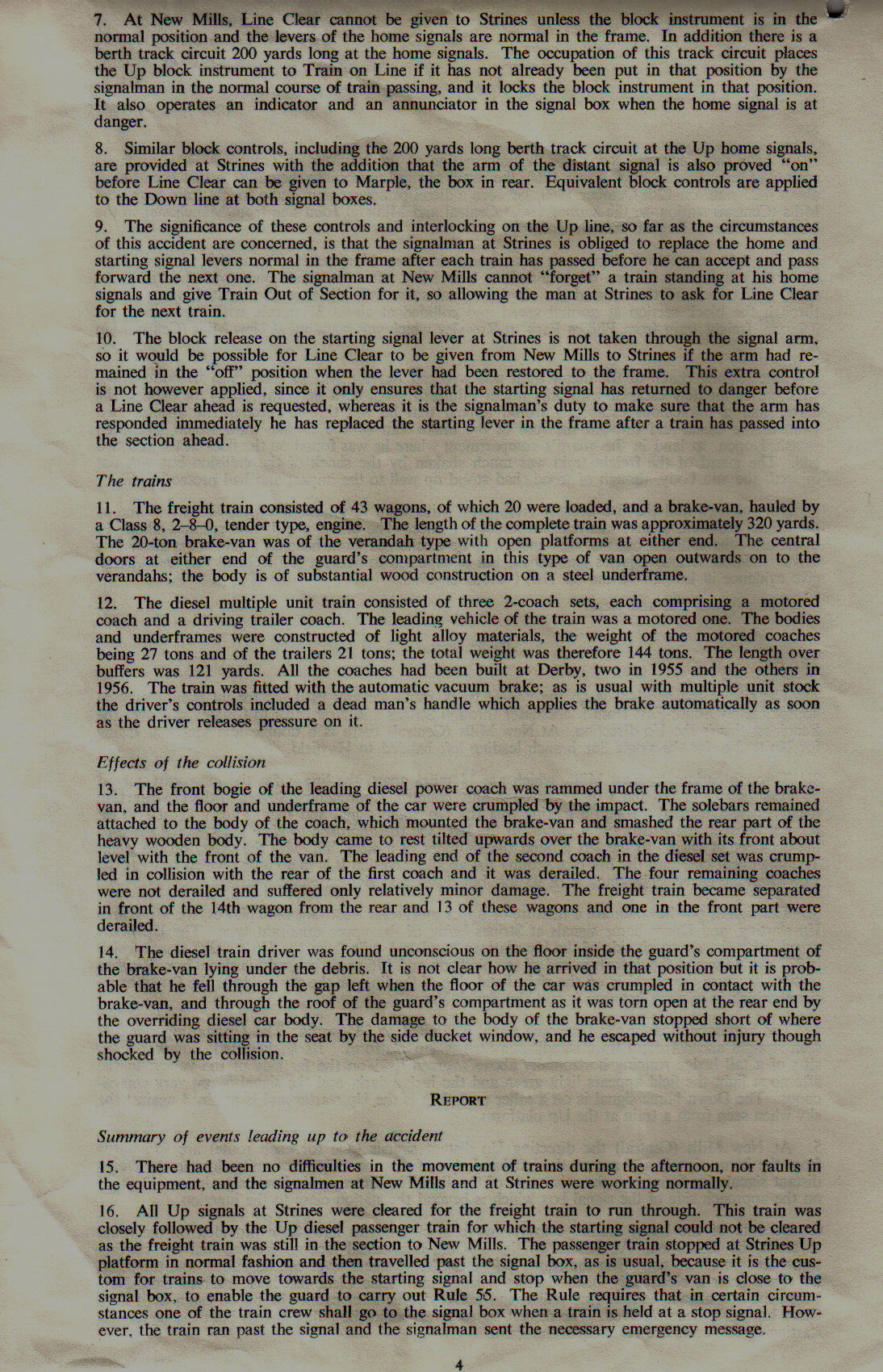
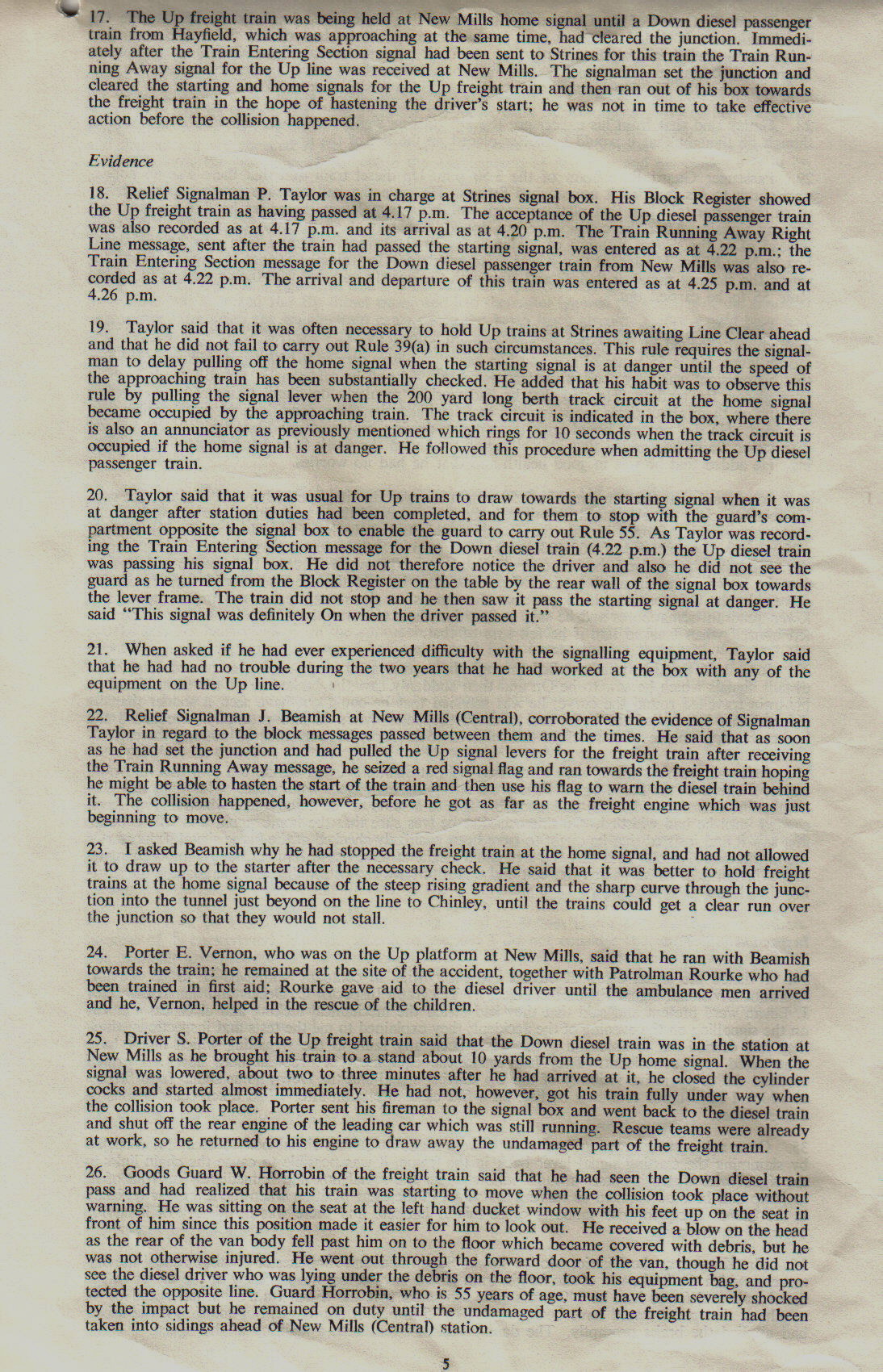
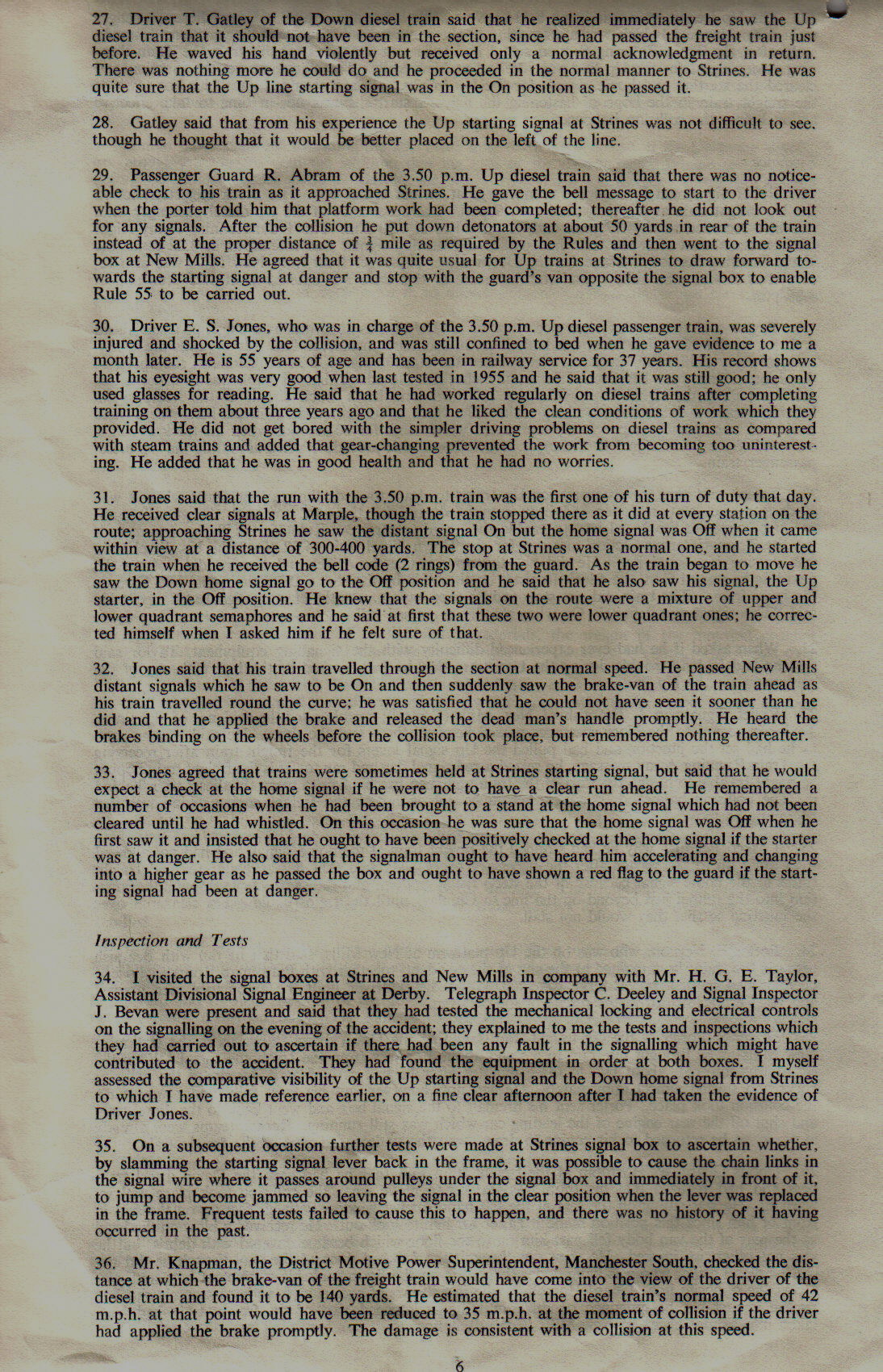

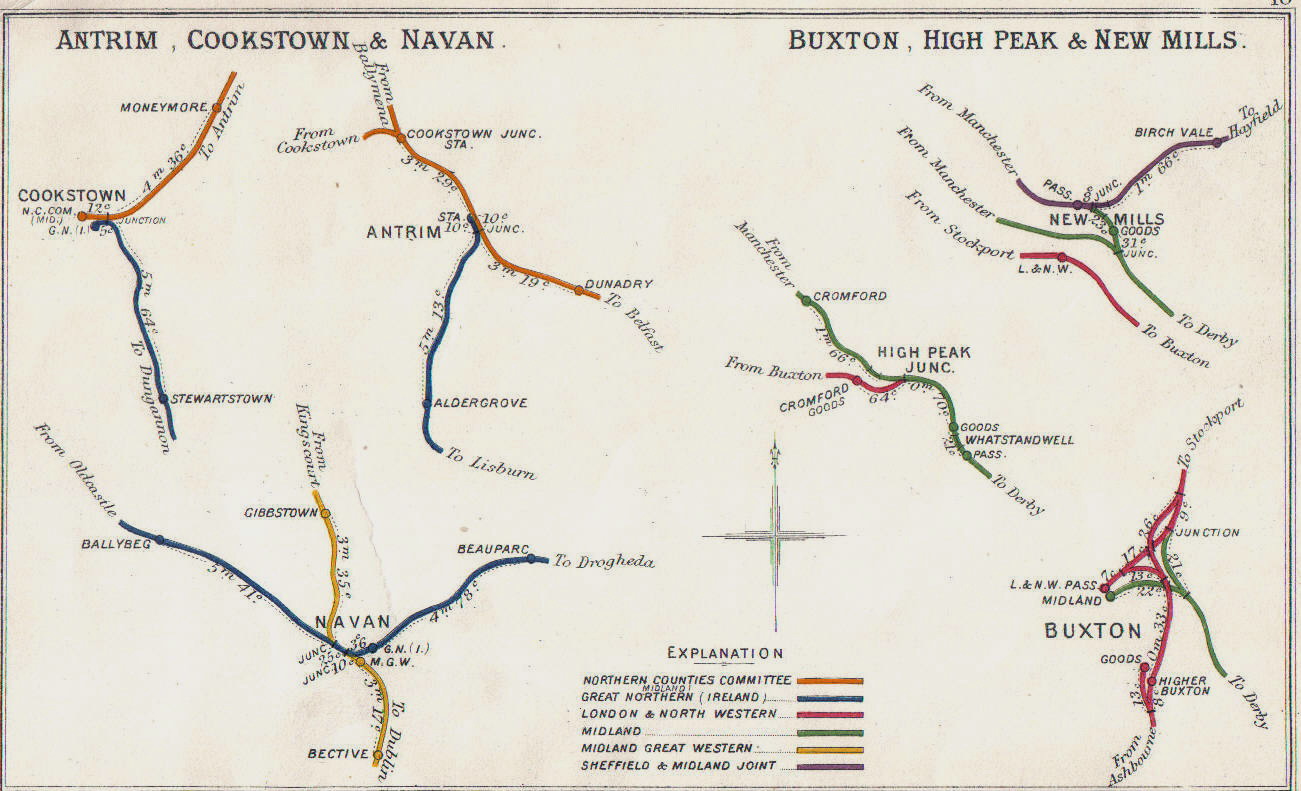
 |







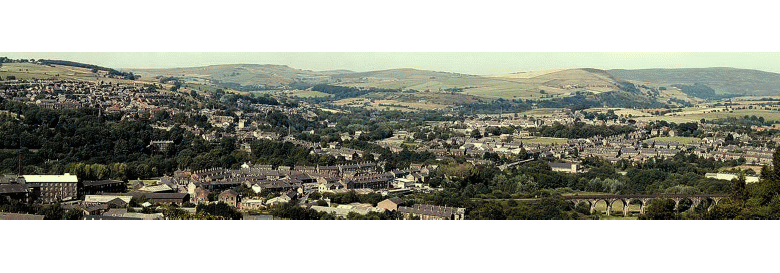


 Only a few hundred yards from New Mills Central Station the diesel rammed into the goods train which had just started to move forward. The first coach, in which the three injured were traveling, leapt about 20 feet upward. Its bodywork shot on top of the guard’s van of the goods train. Driver Evan Jones was hurled from his wrecked diesel cab and thrown into the damaged guards van, and was seriously injured. The girl, 10 year old Margaret was pinned by the legs in seat wreckage and debris in the shattered coach high above the ground. Also injured was a New Mills schoolboy called Philip.
Only a few hundred yards from New Mills Central Station the diesel rammed into the goods train which had just started to move forward. The first coach, in which the three injured were traveling, leapt about 20 feet upward. Its bodywork shot on top of the guard’s van of the goods train. Driver Evan Jones was hurled from his wrecked diesel cab and thrown into the damaged guards van, and was seriously injured. The girl, 10 year old Margaret was pinned by the legs in seat wreckage and debris in the shattered coach high above the ground. Also injured was a New Mills schoolboy called Philip.  Margaret had been sitting toward the front of the diesels first coach, and in front of her, just behind the driver, was 12 year old Philip. He had got up and left his seat as the train was nearing New Mills - a move which probably saved him from serious injury. He had gone toward the door. He was the first of the three to be rescued, and he was taken to Stockport Infirmary suffering from shock and bruises. His mother said it was thought he might have broken a bone in his heel. Mrs. Jones wife of the driver said ‘ he did not seem to know what had happened. He could not speak properly. He has been on the railway since he was 14 and has been driving diesels for two years.’ Philip said ‘ There was a terrific crash and everything began flying around. Luckily they got me out in next to no time.’
Margaret had been sitting toward the front of the diesels first coach, and in front of her, just behind the driver, was 12 year old Philip. He had got up and left his seat as the train was nearing New Mills - a move which probably saved him from serious injury. He had gone toward the door. He was the first of the three to be rescued, and he was taken to Stockport Infirmary suffering from shock and bruises. His mother said it was thought he might have broken a bone in his heel. Mrs. Jones wife of the driver said ‘ he did not seem to know what had happened. He could not speak properly. He has been on the railway since he was 14 and has been driving diesels for two years.’ Philip said ‘ There was a terrific crash and everything began flying around. Luckily they got me out in next to no time.’  More than thirty wagons were derailed on the railway between New Mills and Disley spilling hundreds of tons of Limestone onto the tracks, blocking both lines. The 5 p.m. train from Grindleford to Trafford Park was about a mile from the New Mills end of the Disley tunnel, above the Knathole Wood, when the diesel locomotive and the first two wagons divided from the rest of the train as a result the remaining thirty three wagons became derailed. The incident occurred at about 6 p.m. but no-one was injured. The train was carrying between five and six hundred tons of stone for shipment, and workmen faced the task of removing the stone before repairing the tracks and getting the wagons back onto the lines. The line is known locally as the ‘middle line’ on which the London trains used to run is now used for freight traffic only. Following the blockage trains were rerouted.
More than thirty wagons were derailed on the railway between New Mills and Disley spilling hundreds of tons of Limestone onto the tracks, blocking both lines. The 5 p.m. train from Grindleford to Trafford Park was about a mile from the New Mills end of the Disley tunnel, above the Knathole Wood, when the diesel locomotive and the first two wagons divided from the rest of the train as a result the remaining thirty three wagons became derailed. The incident occurred at about 6 p.m. but no-one was injured. The train was carrying between five and six hundred tons of stone for shipment, and workmen faced the task of removing the stone before repairing the tracks and getting the wagons back onto the lines. The line is known locally as the ‘middle line’ on which the London trains used to run is now used for freight traffic only. Following the blockage trains were rerouted.  Almost exactly a year later the last three wagons of an I.C.I. ‘hopper train’ taking limestone from the company’s quarry at Tunstead, Peak Forest to its Oakliegh Works, Chester were derailed and overturned between Newtown and Disley.
Almost exactly a year later the last three wagons of an I.C.I. ‘hopper train’ taking limestone from the company’s quarry at Tunstead, Peak Forest to its Oakliegh Works, Chester were derailed and overturned between Newtown and Disley. 





